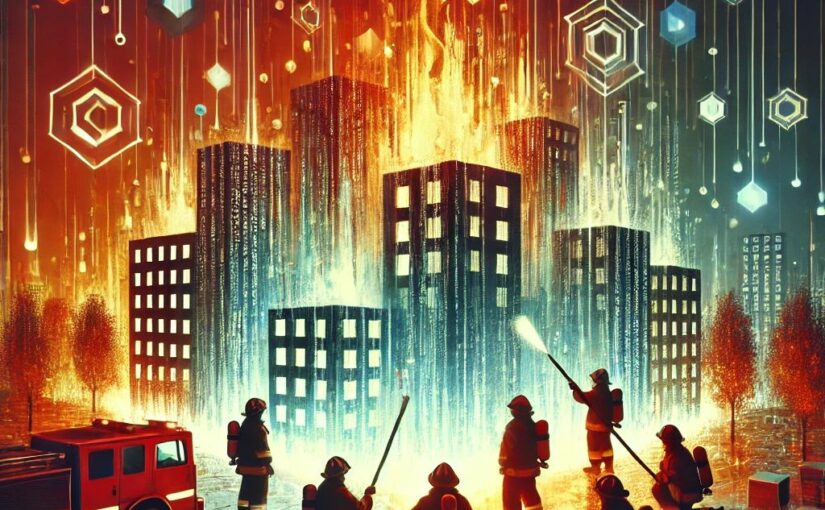The year 2050 is closer than the year 1990, yet we’re still writing code like it’s the 1800s.
It’s 2025, and while we’ve made incredible strides in software development—automated memory management, static analysis tools, refactoring IDEs, and AI copilots like ChatGPT—it still feels like the Wild West. Sure, the tools are better, but the way we approach software remains chaotic, inefficient, and overly reliant on custom solutions.
Every day, thousands of developers solve the same problems repeatedly. Companies roll out their own authentication systems, file upload handlers, and error trackers. Many of these are flawed. Vulnerabilities creep in because we’re not building resilient systems—we’re building digital bonfires.
This isn’t progress. This is the time before the First Industrial Revolution of Software Development.
Lessons from History: What the Past Teaches About Our Digital Fires
1. The Great Fire of Hamburg (1842): Building Without Safety
In 1842, a quarter of Hamburg burned to the ground. The city’s lack of fire safety standards—wooden buildings, narrow streets, no prevention systems—made disaster inevitable.
Software today mirrors this recklessness:
- File upload systems without malware checks.
- APIs with vulnerabilities because “it’s faster to skip security.”
- Custom-built logging systems without consistency or reliability.
After the fire, Hamburg rebuilt with fireproof materials and strict regulations. We need the same shift in software development: adopting universal standards, secure-by-design frameworks, and centralized tools to prevent disaster before it happens.
2. Electrical Sockets in the Early 1900s: Chaos Without Standards
Before standardization, electrical sockets were a mess. Every region had its own plug type, making interoperability nearly impossible. Plugging in a device often meant wasting time finding the right adapter.
Software development today is no different:
- APIs lack consistent patterns.
- Libraries solve the same problem in incompatible ways.
- Developers reinvent logging, error handling, and authentication with every project.
The solution? Standardized, language-agnostic tools—the equivalent of universal plug designs. Imagine APIs and services that integrate seamlessly across languages and frameworks:
- Centralized logging and error tracking APIs, similar to Sentry but designed for internal use with cross-language compatibility.
- High-performance Unix socket APIs for tasks like logging, monitoring, and file scanning.
- Shared SDKs for foundational needs like security or metrics collection.
By building shared infrastructure, we could eliminate redundant work and improve reliability across projects.
3. The Facade Problem: Buying Software for Looks, Not Stability
Imagine buying a house because the facade looks amazing but never checking the foundation. That’s how most software is evaluated today:
- Buyers focus on flashy UIs and marketing demos.
- Security, scalability, and maintainability are often ignored.
This approach leads to brittle, insecure systems. What’s missing? Inspectors for digital bridges—specialized roles that assess software foundations, enforce accountability, and ensure systems are solid beneath their shiny exteriors.
Moving Toward the First Industrial Revolution of Software Development
The Industrial Revolution replaced handcrafting with standardization and mass production. Software development is still stuck in its pre-industrial phase:
- Custom solutions are built repeatedly for the same problems.
- Accountability is rare—no one ensures the “bridge” (software) is stable before it’s deployed.
To mature as an industry, we need:
1. Universal Blueprints
Developers today still create bespoke solutions for common problems. We need standardized tools and APIs, such as:
- A unified SDK for antivirus scanning, accessible via
/usr/sbin/antivirusorunix:///var/run/antivirus. - Centralized APIs for error tracking, metrics, and monitoring, with cross-language support.
2. Specialized Roles
In the 19th century, collapsing bridges led to the creation of specialized roles: architects for design, builders for execution, and inspectors for safety. Software teams need similar specialization:
- System Inspectors to evaluate software for security, scalability, and maintainability.
- Digital Firefighters to enforce standards and proactively address vulnerabilities.
3. Accountability
When a bridge collapses, someone is held responsible. In software, failures are often patched silently or ignored. We need:
- Transparency: Bugs and vulnerabilities must be documented openly.
- Retrospectives: Focused on systemic improvements, not just quick fixes.
Building Digital Cities That Don’t Burn
Imagine a future where software is built like modern cities:
- Fireproof Systems: Universal standards for security, maintainability, and testing.
- Digital Firefighters: Publicly funded teams safeguarding critical infrastructure.
- Inspectors for Digital Bridges: Specialized roles ensuring software is built to last.
AI tools like GPT can help accelerate this process, but they are not the solution. AI is like the steam engine of programming—amplifying productivity but requiring skilled operators. If we don’t lay the right foundations, AI will only magnify our inefficiencies.
This future isn’t about writing more code—it’s about creating resilient, scalable systems that stand the test of time. The tools to build fireproof digital cities are already here. The question is: are we ready to use them?
Let’s move beyond the Wild West of coding and into the Industrial Revolution our industry desperately needs. It’s time to stop building bonfires and start building something that lasts.
